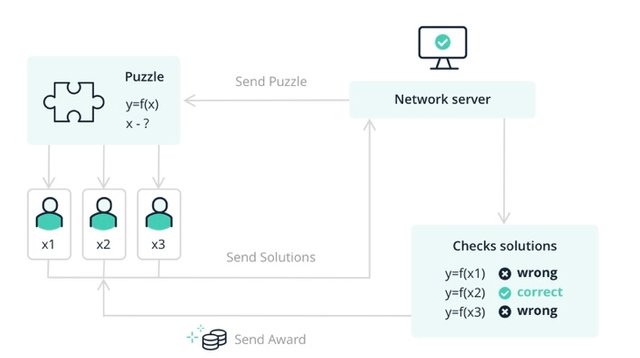Hi everyone.
I’m glad to participate on this season one week three contest.
Here is my entry;

Introduction to blockchain
The existence of cryptocurrency is backup by the smooth operation of a digitally decentralized ledger known as blockchain. One may wonder what a blockchain is all about.
Definition: Blockchain can be defined as digital transaction ledge that is decentralized across several nodes through the operation of Distributed Ledger Technology (DLT). Hence, remains transparent to node that want to explore it and immutable as well.
Blockchain technology awareness exploded after the launching of Bitcoin, the first cryptocurrency, although it has existed years back. A blockchain consist of; a block, chain, consensus mechanism/protocol etc.
Each of these features plays a vital role for the successful operation of a blockchain.
Data in a block of blockchain is not self-generated. It is done by different people called miners using a process known as a consensus mechanism/protocol.
In this discussion, I’ll talk about a concept of block validation known as Proof Of Work consensus mechanism, the first method of block validation in history.
Proof Of Work
Aforesaid, this consensus mechanism is the first method of block validation which is used by bitcoin, the leading cryptocurrencies. It is used in permission less blockchain. Unlike any other method, proof of work is a consensus mechanism that utilizes a computing power in order to verify a block through the process of solving an algorithm which will generate a suitable hash that contains 64 bits characters for the block, then add it to the initial block. The first verifier earns it rewards in the same cryptocurrency, and it always occurs every ten minutes (10 mins). The hash of every block generated begins with zeros.
Proof of work operation does not accept dominance of any miner like it famous counterpart known as proof of stake, but rather the miners earns base on their efforts. The dominating cryptocurrency (Bitcoin and Ethereum) operates on an open source proof of work. This means that anybody can participate.
In a Bitcoin blockchain, the proof of work algorithm code is SHA-256 and the successful verification is what secures the blockchain from any manipulation of the block.
How proof of work consensus mechanism works
Proof of work operations basically occurs in 5 steps.
- Initiation: A transaction is initiated by the user.
- Computation: Immediately, miners compete with their nodes to solve an algorithm.
- Procession of new block: The first person to solve the algorithm emerge the winner and continue the verification and mining of a new coin, which is the rewards.
- Addition of the block: The block is successfully added and encrypted to the blockchain.
Enumerating it in a simple way, assuming that a complex task it given to group of people with a rewarding prices. The first person emerges the winner and receive the reward for participation then another task is supply to the participants. This process keep continuing. That’s how a Proof-Of-Work consensus works.
Some Alter-coins that use proof of work consensus mechanism; Ethereum, Litecoin, Monero, Bitcoin cash etc
Why proof of work is important in the blockchain
Below are the major reasons why proof work is important;
Proof work consensus mechanisms helps in eliminating a fake transaction known as double spending. When a transaction is initiated, miners encrypt and interlink (chain) it by copying the previous hash and generating a new hash. This automatically secure and create a trust transaction.
Mining of new coins of the cryptocurrency as an incentive for a block verification is another important of the proof of work in the blockchain of cryptocurrencies that uses it.
Lastly, the successful validation and mining helps in decentralization of the transaction records to other nodes such that a shutdown of one node does not affect any record.
In a nutshell, the importance of proof of work are; distribution of ledgers (decentralization), mining of the coin, verifications and securing.
Existence of blockchain without proof of work consensus mechanism
A novice may believe that proof of work is the only consensus mechanism that is used to perform the service it renders, but definitely NOT. Blockchain can still exist without it.
Since proof of work concept is the first consensus mechanism, let’s check some of it cons which lead to birth of other concepts.
Blockchains that use proof of work concept have a scalability challenge. A clear example can be seen when a transaction done is on Monero and Steem at the same time. In fact, it is this limitation that brought up the idea of battling blockchain trilemma.
Another cons are the high cost of setup and consumption of electric power because of the powerful computer it uses.
Alternative to proof of works are;
Proof of Stake (PoS), Proof of Elapsed Time (PoET), Proof of Capacity (PoC), Delegated Proof of Stake (DPS) and Pure Proof of Stake (PPoS) etc.
Among all these alternatives, proof of stake is the most adapted alternative because of it features such as low energy consumption, environmental friendly etc.
In Proof of Stake, validators are selected base on the highest staked on the blockchain at that particular time.
Possible ways to improve Proof of Work (PoW)
The major problem of Proof of Work is scalability.
Ethereum blockchain have attempted a better solution to this limitation through the creation of Sidechain operation or use of layer 1 & 2.
In layer 1 solution, sharding is a validation of blocks done by breaking block from bigger to smaller sizes. This method distributes any load which would have cause scalability challenges to other network, thereby increasing the validation speed.
Bitcoin validators can improve their consensus mechanism through the application of Bitcoin Lightening Network (BLN). This will reduce scaling capacity from 10 mins to a maximum of 2 mins.
Layer 2 solution such as Optimism roll ups, Starkware and Arbitrum, Plasma, zero-knowledge rollups (ZK - Rollups) are all layer 2 solutions. Thses are all off chains that pull off some transactions on main chain and return it immediately after validations.
Conclusion
Blockchain can be regarded as an ecosystem of cryptocurrency because it comprises several features. Everyday, developers come up with different alternatives that favour’s users more than the initial. Irrespective of the fact that POW is the first is the consensus mechanism, I prefer it more than any alternative.
Thanks for reading my entry.

